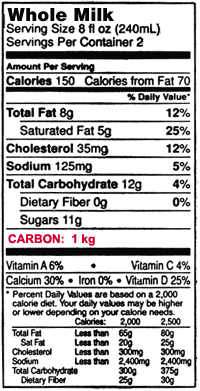OK, this is way outside the bioregion, but interesting nonetheless: British supermarket chain Tesco–apparently, the world’s fourth-largest retailer–is going to start labelling the carbon footprint of its foods.

The idea is not without its problems. To do this right will require a huge data collection exercise. But in some ways that’s the easy part. The hard part is to figure out the rules of the game—which is tough, since there’s no common agreement about how to do this kind of analysis.
It’s a problem of scope: what, precisely, should be included in the tally of a food’s climate impacts?
Obviously, Tesco would want to include the carbon and methane emissions for growing food—everything from fertilizer to tractor fuel—plus carbon emitted in transporting food from farm field to the grocery store. Foods trucked from far away, or that require lots of energy-intensive fertilizers, will have a larger impacts on the climate. That’s clear enough.
But what about, say, the carbon impact of home refrigeration? Refrigerators and freezers are the biggest consumers of power in most peoples’ homes; so ideally, a carbon impact assessment would account for that. That said, once your fridge is purchased and running, putting some extra veggies in the crisper does basically squat to alter your power consumption. So does buying a gallon of milk add to the carbon impacts of home refrigeration, or no? To say no ignores the large climate impact of refrigerators; to say yes may ascribe too large a carbon impact to any single food purchase.
Or how about home cooking? I’d want the label for a loaf of bread to include the carbon impact of commercial ovens. But commercial ovens can be pretty efficient, compared with baking at home—so you’d also want to include the carbon impacts of home baking on every bag of flour, no? Otherwise, you might get the impression that baking bread at home is environmentally preferable to buying it at the store—an impression that very well could be wrong.
In case you think these are minor quibbles, take a look at these charts, derived from this analysis (beware, big pdf) of the US food system. Home refrigeration and preparation accounted for nearly a third of all energy used in the food system—more than twice as much as transportation. And what’s more, when you get into the numbers a bit, about a third of total transportation energy represents trips by consumers to and from grocery stores. Looking at the total consumer side of the food system, refrigerators plus cooking plus cars use at least as much energy as does growing and transporting food. So if Tesco doesn’t look at what happens to food after it leaves the store, its labels will be missing a big part of the climate story.
Tesco has given $10 million grant to Oxford University’s Environmental Change Institute to figure out all these questions—and I wish them all the luck in the world. If they come up with a good & credible way of thinking about these issues—and effective labels that give consumers solid information about the impacts of their choices—perhaps US retailers will follow their lead. (Yeah, right.)








Matt the Engineer
Of course, that’s just looking at a few of the problems. Here’s a few more: 1. How would they label transportation impacts? Sure, they can get order-of magnitude close – if the goods come in from Argentina. But does an Oxford milk farm have to label their milk differently if they deliver it to London versus Lancaster?2. How about the pieces? Milk is straightforward compared to, say, a microwave dinner. Would a microwave dinner manufacturer have to figure out the carbon impact from each ingredient? What if the parmesan sauce used on their chicken dinner is purchased pre-made from another manufacturer in, say, Spain? Would they have to require the out-of-country manufacturer to figure out the carbon impact of all of the sauce ingredients?3. Combine 1 & 2. What if the parmesan sauce maker switches from an Oxford milk to an Argentinean milk? Would they have to inform the microwave dinner manufacturer, and have them change their label? What if milk is bought on the open market, switching sources each month?4. Gaming the system. For instance, using local suppliers only when you’re creating a label.Ok, I’m getting carried away. Clearly it will be a tricky process, or an inaccurate one. My money’s on them just coming up with a general kg of carbon per type of product, and having manufacturers add transportation impact based on how far their primary ingredient typically travels. Inaccurate, but reasonably traceable.
Alan Durning
All of these complexities are why, ultimately, the best solution to the labeling problem lies in the one product label that everyone reads: the price tag.Pricing fossil fuels at the well head or mine mouth—or the point of entry into a country or state– to reflect greenhouse gas emissions will automatically convey information all the way through the supply chain. Call me a market fundamentalist on this point, if you will. But I believe the price system is far, far, far more powerful and accurate at conveying such information.That said, I applaud the Tesco initiative.
Dan
Labeling the C footprint is a good start. Then people can make choices to pay more for a smaller footprint. When the price signals change, the label may explain why. But I’m with Alan: until prices reflect the true cost, not much will change.